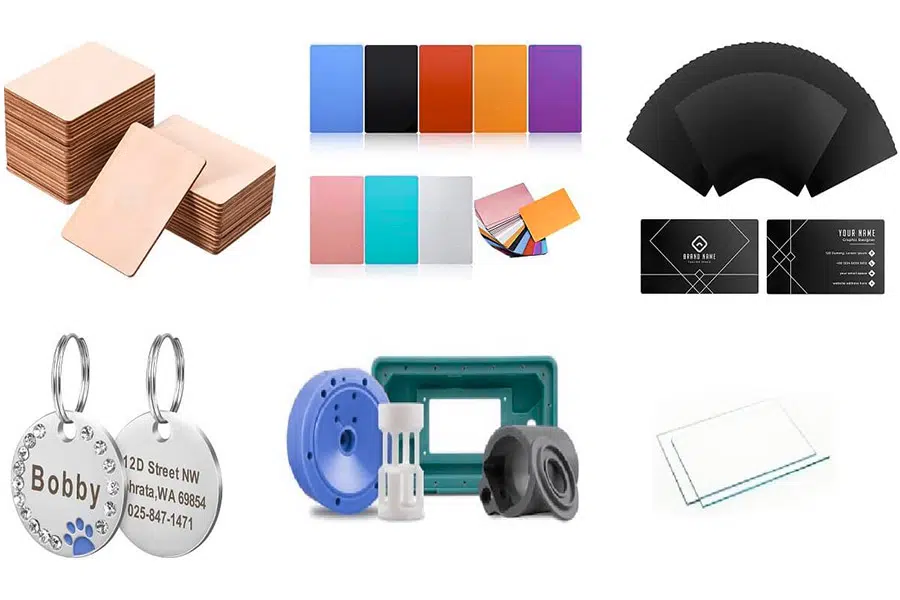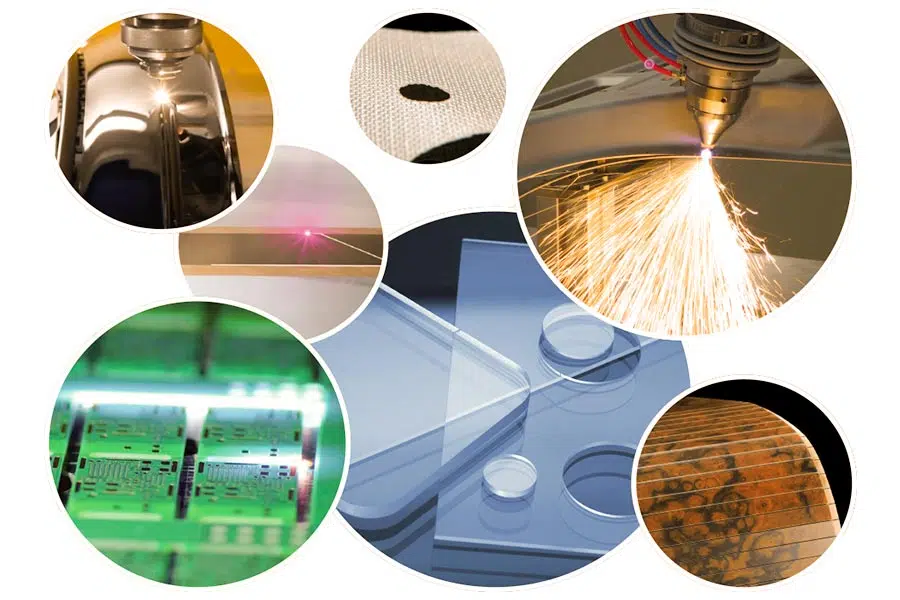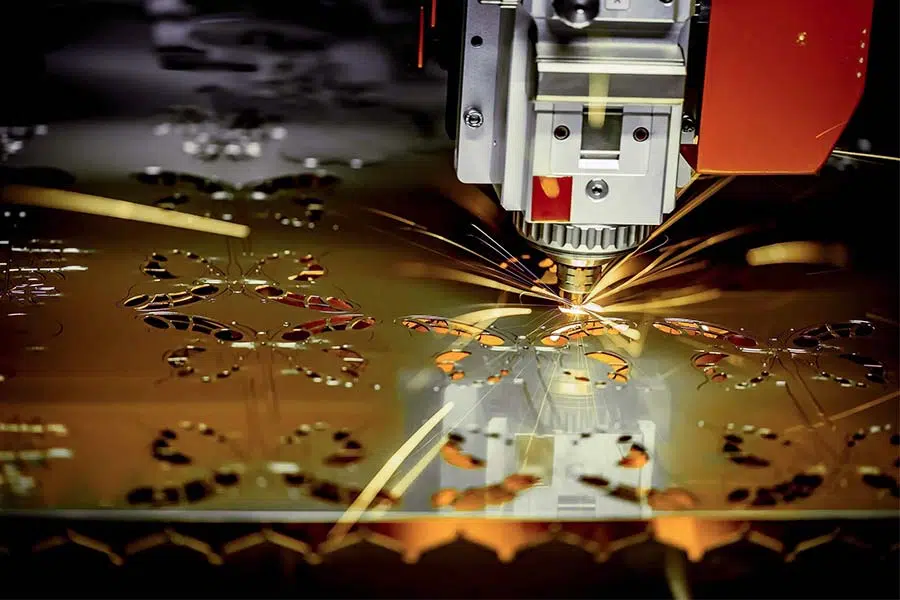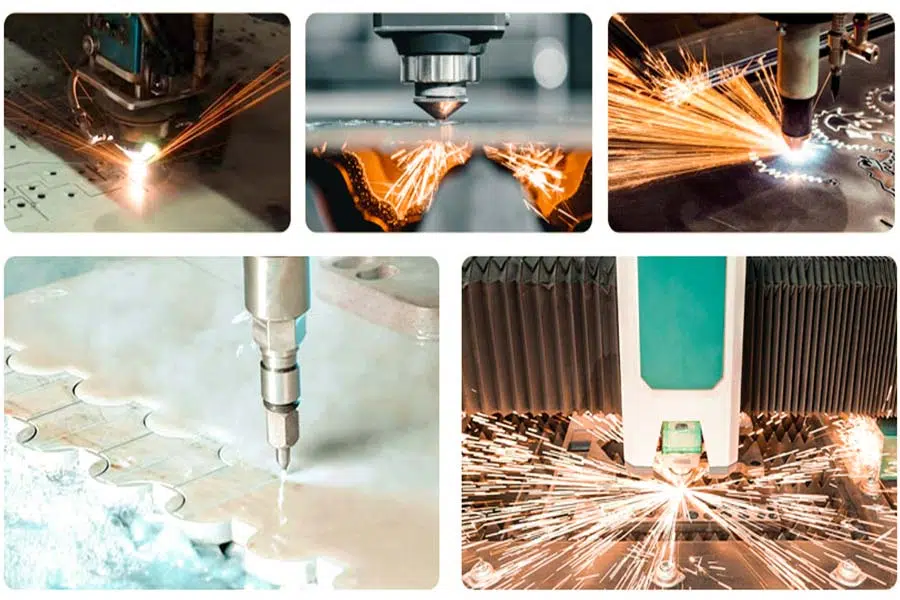As a typical representative of advanced manufacturing technology, laser cutting technology has been widely used in aerospace, automobile manufacturing, consumer electronics and many other fields with the significant advantages of high precision, high efficiency and non-contact processing. The core principle is that a laser beam with a high energy density interacts with the material to produce a thermal effect, thereby achieving the separation of the material. This article will systematically analyze the application scope and process characteristics of laser cutting technology, and help readers clearly understand and accurately select materials suitable for laser cutting.
What Materials Are Universally Laser-Cuttable?
Laser cutting technology has a wide range of applicability and can be used for many types of materials, including metal materials and non-metal materials. The following is a detailed summary of metal materials and non-metal materials that can be used for laser cutting:
Metal materials
Laser cutting has a wide range of applications on metal materials, covering almost all common metal types, including but not limited to:
- Stainless steel: It has the characteristics of corrosion resistance, high temperature resistance, good mechanical properties, etc., and is widely used in industrial fields. Laser-cut stainless steel enables efficient and precise cutting to meet the needs of a wide range of complex shapes.
- Carbon steel: It is one of the main metal materials that can be cut by modern laser cutting systems, with a maximum cutting thickness of up to 20 mm. Using the oxidation melting cutting mechanism, the cutting seam of cutting carbon steel can be controlled in a satisfactory width range, and the cutting seam can be narrow to about 0.1 mm for thin plates.
- Aluminum alloy: It has the characteristics of light weight and high strength, and is widely used in aviation, aerospace, automobile and other fields. Laser cutting of aluminum alloys can achieve high-quality cutting results with almost no mechanical contact during the cutting process, avoiding tool wear.
- Titanium alloy: one of the commonly used materials in the aircraft industry, laser cutting titanium alloy is of good quality, although there may be a little sticky slag at the bottom of the cutting seam, but it is easy to remove.
- Copper and copper alloys: such as brass, etc., with good electrical and thermal conductivity. Laser cutting of copper and copper alloys requires good control of cutting speed and energy density to avoid problems such as material deformation and oxidation.
- Nickel-based alloys: also known as super alloys, there are many varieties, most of which can be oxidized and melt cut.

Non-metal materials
Laser cutting technology is equally applicable to a wide range of non-metallic materials, including but not limited to:
- Plastics: such as polyester, polypropylene, polyethylene, polyurethane, polystyrene, etc. Laser-cut plastics can be cut quickly and precisely with a flat cut and no secondary processing.
- Wood: Includes various types of hardwoods and softwoods, such as oak, elm, maple, pine, and softwood, among others. Laser-cut wood has the advantages of fast speed and smooth incision, and is widely used in furniture manufacturing, architectural decoration and other fields.
- Glass and quartz: Although glass and quartz have a low absorption rate of laser, high-quality cuts can also be achieved by adjusting parameters such as laser power, cutting speed, and gas pressure.
- Ceramic: For some types of man-made or decorative ceramics, laser cutting is also feasible. However, it is important to note that not all ceramic materials are suitable for laser cutting.
- Textiles and leather: These materials are easy to process, foldable, bendable, etc., and are widely used in electronics, home appliances, medical, packaging and other industries. Laser-cut textiles and leather enable fine pattern and texture cutting.
- Paper and cardboard: Laser cutting usually leaves no marks on these materials, so they are often used to make labels, packaging, and more.
- Polymer materials: such as rubber, polyester, etc., these materials can also be processed by laser cutting. However, it is necessary to pay attention to the problem of material deformation, such as the deformation of PBT material during the heating process, so it is necessary to reasonably control the cutting parameters and cutting methods.

What Materials Are Strictly Forbidden?
The large amount of heat generated by laser cutters makes them unsuitable for cutting certain materials. In some cases, the composition of the materials themselves makes them poor laser cutting materials because of the risk of fire or toxic fumes.
1. Polyvinyl chloride
PVC stands for polyvinyl chloride. It is a polymer that produces chlorine gas when exposed to a laser. First, the gas is irritating and can cause irritation and burns to the eyes, nose, skin, and respiratory tract. Secondly, this gas is corrosive. It can damage the frame of the machine, which is made of metal. It can also damage the laser, as well as other parts of the machine. So, if you want to use the machine for a long time and keep yourself safe, never cut or engrave PVC.
2. Polycarbonate
Polycarbonate is prone to discoloration when heated by laser. In addition, it is prone to fire.
3. Polystyrene and polypropylene foam
These are two types of foam, neither of which is suitable for laser cutting. First, they catch fire quickly, and when you try to cut them with a laser, they just melt; It is impossible to cut at all.
4. High-density polyethylene
You can’t cut it with a laser because it will melt and become sticky under laser irradiation. Secondly, it will also catch fire.
5. Coated carbon fiber
If the carbon fiber is coated, then when laser cutting, the coating releases various toxic gases. These fumes are very harmful and can cause respiratory diseases.
6. Galvanized metal
The galvanized metal surface is coated with a layer of zinc to prevent rust. When the laser beam comes into contact with the galvanized metal, it heats the zinc coating and vaporizes it. This process releases zinc oxide fumes into the air. Zinc oxide is harmful to human health. Ensuring the health and safety of operators is paramount, so materials that emit toxic fumes such as zinc oxide are not suitable for laser processing.

Which Materials Require Special Gas Assist?
In the laser cutting process, some specific materials need to use special gases to improve the cutting quality, which can be mainly divided into two categories: oxygen-dependent and nitrogen-protected, and the specific requirements are as follows:
1. Oxygen-dependent materials
(1) Carbon steel
- Gas requirements: Pure oxygen with a purity of 99.5% and a pressure control of 0.8 – 2 bar.
- What it does: Oxygen acts as an accelerator and reacts chemically with iron to significantly increase cutting speeds by up to 30% to 50%. However, after cutting, an oxide layer with a thickness of about 0.1 to 0.3 mm is produced, which needs to be sanded and other treatments are required.
- Application scenario: It is suitable for thick plate cutting (plate thickness ≥ 10mm) or scenarios with high requirements for processing speed.
(2) Copper
- Gas requirements: high-pressure oxygen is required, and the pressure should be ≥3 bar.
- Function: Oxygen will partially oxidize the copper, reduce the reflectivity of the copper to the laser, and improve the absorption of laser energy by the material. The cut surface forms an oxide film, which needs to be removed later.
- Note: Due to the high reflectivity of copper (≥80%), it will cause a large loss of laser energy, so regular maintenance of the lens is required.
2. Nitrogen protection materials
(1) Aluminum
- Gas requirements: Nitrogen pressure is maintained at 15 – 25 bar.
- Function: It can effectively prevent the slag from adhering to the cutting surface and avoid the oxidation of aluminum. The inertness of nitrogen results in a smooth and clean aluminium cutting surface, reducing the need for subsequent processing steps.
- Parameter optimization: for thin aluminum sheets (thickness ≤ 3 mm), low-pressure nitrogen at 5 – 10 bar can be used; Thick plates need to use high-pressure nitrogen to enhance the slag removal effect.
(2) Copper (brass, copper)
- Gas requirements: nitrogen flow rate should be ≥30m³/h, and purity should be ≥99.99%.
- Function: It suppresses energy loss caused by the high reflectivity of brass (70% reflectivity) and copper (80% reflectivity) and prevents material deformation due to excessive heat conduction.
- Special requirements: When cutting brass, pulse waveform modulation (such as square wave, sine wave) is required to improve the absorption efficiency of the material to laser energy.

(3) Stainless steel
- Gas requirements: nitrogen purity needs to be ≥ 99.99%, pressure ≥ 1Mpa (pressure ≥ 2Mpa when cutting thick plates).
- Function: It can eliminate the oxidation reaction and keep the natural color of the metal on the cutting surface without subsequent treatment. For stainless steels with a thickness of more than 8mm, the nitrogen purity needs to be increased to 99.999%.
- Cost considerations: the larger the plate thickness, the greater the nitrogen consumption, and the relatively high cost of thick plate cutting.
The core role of gas assist
| Type of gas | Main role | Applicable Materials | Limitations |
|---|---|---|---|
| Oxygen | Boost combustion speed and enhance cutting capacity | Carbon steel, copper | Oxide layer is generated, which requires post-treatment |
| Nitrogen | Anti-oxidation, keep the surface smooth | Stainless steel, aluminum, copper | The cutting capacity is weaker than oxygen, and the cost is high |
| Pressurized air | Economical and practical, balancing efficiency and cost | Sheet metal parts, non-metallic | The end face of the incision is yellow, which is not suitable for high precision |
Which Composite Materials Require Custom Settings?
Carbon Fiber Reinforced Plastics (CFRP)
Core setup logic
1.Pulse mode necessity
- Frequency range: 500-1000Hz
- Mechanism of action:
- The pulsed laser vaporizes the resin matrix at a high temperature instantaneously, reducing the heat-affected zone (HAZ) and avoiding delamination at the carbon fiber and resin interface.
- The high-frequency pulses control the energy input and prevent the oxidation of carbon fibers caused by continuous wave lasers (carbon-oxygen reaction to form CO/CO₂ gas, which weakens the strength of the material).
2.Vacuum dedusting system
- Safety threshold: The concentration of carbon dust should be kept below the explosion limit (LEL) (typically < 50 g/m³).
- Equipment requirements: Equipped with HEPA filter (0.3μm particle filtration efficiency ≥99.97%) and electrostatic adsorption device.
3.Extended process parameters
| Parameter | Recommended values | Function |
|---|---|---|
| Laser wavelength | 10.6μm(CO₂) | The resin has a high absorption rate and reduces reflection loss |
| Focal length | 6-8mm | Balance spot diameter with cutting depth |
| Assist gases | N₂ (Purity≥99.99%) | It isolates oxygen and inhibits oxidation reactions |
Honeycomb sandwich panels
- Power and speed: Honeycomb sandwich panels are usually composed of aluminum honeycomb cores and carbon fiber panels. The laser power and cutting speed need to be precisely controlled when cutting. For example, the power can be set to 300W and the speed can be set to 2m/min to ensure cutting quality and efficiency.
- Cutting angle: The cutting angle of honeycomb sandwich panels needs to be strictly kept vertical to prevent the core material from melting and collapsing. This helps maintain the structural integrity of the material and reduces defects during the cutting process.
What Emerging Materials Are Gaining Traction?
In the field of materials science, biodegradable plastics (such as PLA) and transparent conductive materials (such as ITO glass) are emerging materials that have attracted much attention in recent years, and they have shown significant advantages in terms of environmental protection, functionality and application scenarios.
Biodegradable Plastics (PLA)
Core features
Environmentally friendly and degradable
- The raw material comes from renewable resources such as corn starch, and the degradation product is lactic acid (which is not harmful to the environment).
- The amount of CO₂ released during incineration is only 50% of that of conventional plastics such as PE, and there are no toxic gases such as sulfides.
Excellent mechanical properties
- The tensile strength ≥ 50MPa (close to engineering plastic ABS), which is suitable for the manufacture of high-load-bearing parts.
- The elongation is >5%, which is convenient for thermoforming processing (e.g. cup lids, trays).
Wide processing adaptability
- 3D printing: melting point 160-180 °C, low shrinkage (<0.5%) to ensure printing accuracy.
- Film extrusion: oxygen permeability < 50cc/m²·24h, and the freshness performance is better than that of PE film.
Application areas
- Packaging materials: PLA has good transparency and heat resistance, and is suitable for food packaging and other fields.
- Fibers and nonwovens: PLA can be blended with other fiber materials to make biodegradable textiles.
- Biomedical: PLA has good biocompatibility and degradability, and is widely used in the field of medical devices, such as sutures, bone nails, etc.
Transparent conductive material (ITO glass)
Technological breakthroughs
Optoelectronic performance optimization
- Resistivity: 10⁶→10⁴Ω·cm (by nano-silver wire composite technology).
- Light transmittance: 85%→92% (with multi-layer anti-reflective coating).
Laser processing innovation
1064nm wavelength 100ns pulse: cutting edge roughness <0.1μm, accuracy ± 0.01mm. Dynamic focusing technology: support 3D curved glass cutting (radius of curvature>5mm).
Application areas
- Touch panel industry: ITO glass is the main material for touch devices such as smartphones and tablets. Its high transparency and good conductivity make touch operations more sensitive and accurate.
- Other electronic devices: ITO glass is also widely used in medical equipment such as electron microscopes and X-ray machines, as well as in-vehicle touch screens.
How to Choose the Right Material for Laser Cutting?
There are several factors to consider when choosing the right laser cutting material. Here are some key selection factors:
1. Type of materials used
Laser cutting machines have the ability to cut many different types of materials, including but not limited to metals, non-metals, plastics, wood, glass and ceramics. This article mainly discusses and analyzes the problems and countermeasures existing in the application of laser cutting machines. In the process of selecting materials, the first task is to confirm that these materials are the types that the laser cutting machine can handle.
2. Thickness of materials used
Different types of laser cutting machines have their own specific material thickness requirements. For some special parts or workpieces, the machining accuracy is very high, so higher requirements are put forward for material thickness control. In order to ensure the quality and efficiency of cutting, we need to choose the appropriate material thickness. Normally, the thickness of laser cutting materials is determined by the output power of the laser. Typically, the higher the power of a laser, the greater the thickness of material it can cut. Therefore, in the process of selecting materials, the most suitable material thickness should be determined based on the power requirements and cutting standards of the laser cutting machine.
3. Treat the surface of the material
Some materials require specific surface treatment, such as coating or coating, which can increase the absorption efficiency of the laser and optimize the cutting quality. For example, when processing certain metal materials, by applying specific coatings, their ability to absorb laser light can be effectively enhanced, thereby further improving the cutting effect.
4. Regarding the thermal expansion coefficient of materials
The thermal expansion characteristics of materials will affect the quality and accuracy of cutting. In order to reduce thermal deformation and errors during cutting, we should choose materials with relatively low thermal expansion coefficients.
5. Chemical properties of materials
Certain chemicals may affect laser cutting results, such as producing smoke or corrosive gases. Chemically stable materials need to be selected to ensure the smoothness of the cutting process and the quality of the material after cutting.
6. Cutting requirements
Different cutting requirements also affect material selection. For example, for parts that require high-precision cutting, you may need to choose a laser cutting machine and corresponding materials with higher cutting accuracy and stability. At the same time, for materials that require special cutting shapes or sizes, the cutting capabilities and flexibility of the laser cutting machine also need to be considered.
7. Cost considerations
There is also a cost factor to consider whenchoosing materials for laser cutting. The cost of different materials varies greatly, and the appropriate material needs to be selected based on budget and cutting requirements. At the same time, the operating costs and maintenance costs of the laser cutting machine also need to be considered to ensure that the overall cost-effectiveness is maximized.

Start your laser cutting project at LS
At LS, we specialize in precision laser cutting services, focusing ondelivering high-quality metal cutting solutions for a variety ofindustries. With lSO 9001:2015 certification and advanced lasercutting technology, we ensure precise cuts, smooth edges, andexceptional accuracy for complex metal components. Whetheryou’re working with stainless steel, aluminum, or other metals, ourexperienced team guarantees minimal material waste and fast,consistent results. From prototyping to large-scale production, weoffer cost-effective solutions tailored to your specific projectrequirements, ensuring both efficiency and superior quality.
Conclusion
Laser cutting technology has a wide range of material applicability and can efficiently cut a variety of metal and non-metal materials, as well as composite materials and special materials. In practical applications, appropriate laser cutting parameters and equipment need to be selected according to specific materials and processing requirements to ensure the best cutting effect. With the continuous development and advancement of technology, the application scope of laser cutting will continue to expand and optimize, providing more efficient, precise and flexible processing solutions for various manufacturing and processing industries.

Contact us now to get exclusive CNC machining solutions!
📞 Phone: +86 185 6675 9667
📧 Email: info@longshengmfg.com
🌐 Website: https://www.longshengmfg.com/
Disclaimer
The content appearing on this webpage is for informational purposes only. LS makes no representation or warranty of any kind, be it expressed or implied, as to the accuracy, completeness, or validity of the information. Any performance parameters, geometric tolerances, specific design features, quality and types of materials, or processes should not be inferred to represent what will be delivered by third-party suppliers or manufacturers through LS’s network. Buyers seeking quotes for parts are responsible for defining the specific requirements for those parts. Please contact to our for more information.
Team LS
This article was written by various LS contributors. LS is a leading resource on manufacturing with CNC machining, sheet metal fabrication, 3D printing, injection molding,metal stamping and more.



Hello, I enjoy reading all of your article post. I like to write a little comment to support you.
Thank you for your support, each article is written by ourselves, we will update the article every day, you can subscription LS, wish you a happy day.
Pingback: What is the difference between CNC and laser cutting wood?